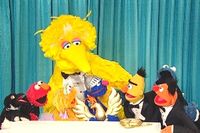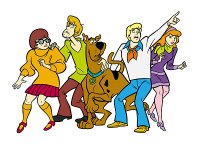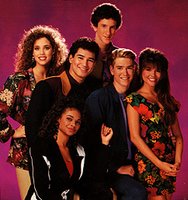 SESAME STREET
SESAME STREET
Made by: PBS/The Children's Television Workshop
Shown on: Channel 4
Years shown: 1969 - present day
Theme tune: “Sunny day, chasing the clouds away/Find my way to where the air is sweet/Can you tell me how to get/How to get to Sesame Street?”
Like all great long-running children’s TV series, Sesame Street courted its fair share of controversy, which over thirty years later, seems hard to believe. What could be contentious about a programme which teaches you to share, tolerate others, and correctly identify the letters of the alphabet? Sesame Street broke the mould because it was set in a slightly run-down Brooklyn neighbourhood, a place where real people were supposed to live, a place that they hoped the pre-school viewers would identify with. There were trash-cans lying around, washing was hung out to dry, and the people who lived in the neighbourhood were both multi-cultural and mainly working class.
But in other ways, Sesame Street probably wasn’t typical of American neighbourhoods - the inhabitants, for one, were somewhat ‘colourful’. Everyone knows that Sesame Street was the forerunner of The Muppet Show, and it was here that Jim Henson really cut his puppeteering teeth, with some of his most memorable and best-loved creations.
Most famous of all has to be Big Bird, the enormous yellow creature who was half canary, half ostrich, and who was intended as the voice of the viewing child, i.e. he was a bit dense, and needed everything spelled out for him in short sentences and with visual aids. His best friend was the woolly-mammoth-like Snuffleupagus, also intellectually-challenged, who was a couple of poor blokes doing a pantomime-horse routine.
Everyone’s favourite single-sex couple were Bert and Ernie, an Odd Couple for the kindergarten generation. Bert had a head shaped like a banana, and a prominent mono-brow, and he was the tetchy, uptight one; his room-mate Ernie wore a stripy sweater and liked his rubber ducky. He was simple but not stupid, and liked to indulge in the occasional prank on his long-suffering friend.
If Bert and Ernie’s function was to educate about the mechanics of friendships, the Two-Headed Monster surely taught us all we needed to know about co-operation and compromise (and conjoined twins?). The two halves could live harmoniously most of the time, but would often hit a brick wall when they wanted to go and do different things in different directions. Didn’t happen as often as you might expect.
One of the show’s legends was the fabulous Cookie Monster, a blue, goggle-eyed harmless maniac, obsessed with consuming large quantities of his favourite snack. He didn’t have much to say for himself, except, “Cookie! Cookie!” - unless he was presenting the ingenious Monster-Piece Theater, in the guise of Alastair Cookie-Monster.
Grover was a little more articulate; he was blue, and bandy-limbed, and he would talk to children about different issues, which would usually culminate with them all hugging him. Which was odd, as he was pretty annoying. Another somewhat grating character was Telly Monster, red with an orange nose, who was there to let children know that it was okay to be anxious about life - except that in Telly’s case, it was a real debilitating condition, seeing as he was wary of almost every commonplace object or occurrence.
One of the street’s residents was the perennially bad-tempered Oscar the Grouch. He lived in a trash-can, from which he emerged to berate people or tell them to leave him alone. Oscar was not in touch with his sensitive side. Eventually, he was joined by Maria, his female equivalent; they were obviously crazy about each other, but would never admit it.
Lest we forget, there was also Count von Count, a Dracula-alike, who was obsessed with counting everything in his sight. His counting was always punctuated with cackling laughter and the crash of thunder and lightning, but rarely did he celebrate by exsanguinating the kids in the studio.
Adding to the mayhem was slick game-show host, Guy Smiley; the cutesy and wildly popular midget-monster Elmo; piano-playing swot, Prairie Dawn; Gladys the Cow; The Amazing Mumford; and of course, Kermit the Frog, who began his career as a Sesame Street journalist, reporting on such ground-breaking events as Rapunzel letting down her hair, and Humpty Dumpty falling off the wall.
The Muppet population was counter-balanced by a selection of human neighbours, all honest, well-meaning folk, and no muggers, gang-bangers or any other unsavoury characters you might be likely to meet in downstate New York. There was fatherly Bob (Bob McGrath), Linda (Linda Bove), who was deaf and gave us the chance to learn American Sign Language (useless to Brits, obviously), David (Northern Calloway), Carlo (Carlo Alban), Susan (Loretta Long), and Gordon (Matt Robinson, then Hall Miller, and finally Roscoe Orman.) But I think everyone remembers the Hispanic sweethearts, Luis and Maria (Emilio Delgado and Sonia Manzano), who ran a repair shop, taught us all some valuable Spanish, and then had a baby - cue lots of potentially difficult questions about the facts of life from all the street’s monsters. Finally, there was old Mr Hooper who ran the news-stand; and when actor Will Lee snuffed it unexpectedly, the programme used this opportunity to teach Elmo about the grief of losing a loved one. Like The Muppet Show, Sesame Street also had its fair share of celebrity guests dropping in, including Hilary Rodham Clinton, Little Richard, and pretty much everyone in between.
In between studio sequences, there were loads of educational-slash-fun segments. There were a number of psychedelic animations to make counting and the alphabet palatable, the most celebrated of which must be that weird pinball sequence, which was on virtually every show, with the funked-up tune: “Onetwothreefourfive, sixseveneightnineten, eleventwelveeeee…” There was also one about a woman who carried a fruit basket around on her head, and a rabbit superhero, who zoomed in, crooning, “It is I, Captain Vegetable, with my carrot and my celery!”, which still didn’t make me order salads.
The part which everyone used as a toilet break was the five minute slot where we’d see what life was like for children in different parts of America/the world. Cue children skating to school in the Yukon, working in a Nike factory in India, or living in a high-rise apartment in New York. They were a bit dull, to be honest, especially if you lived in suburban Britain.
We were also frequently invited to observe that “One of these kids is doing his own thing…” or “One of these things is not like the others”, and take a wild stab at which one was the odd one out. In my opinion this was a wasted opportunity - they never had three kids skating into old ladies and one smoking a cigarette.
The songs, though, were the stuff of genius. Some of them had dubious educational value (anything sung by Ernie about his rubber ducky, or Cookie Monster’s ‘Me Lost Me Cookie at the Disco’), but then there was the inspired ‘Letter B’ to the tune of The Beatles’ ‘Let it Be’, and ‘Born to Add’ in place of Bruce Springsteen’s ‘Born to Run.’
There have been over 3000 episodes of Sesame Street, and special mention should be made of the tireless vocal artists, including Jerry Nelson, Frank Oz (Bert, Cookie, Grover, Harvey Kneeslapper, among others), and, of course, the late Jim Henson, who gave life to Ernie, Guy Smiley and Kermit. This review was brought to you today by the letters G, R and by the number 8, but is not - much as I would like it to be - a production of the Children’s Television Workshop.
SQUARE EYES RATING:10/10
(Thanks to wikipedia for the borrowed pic)



